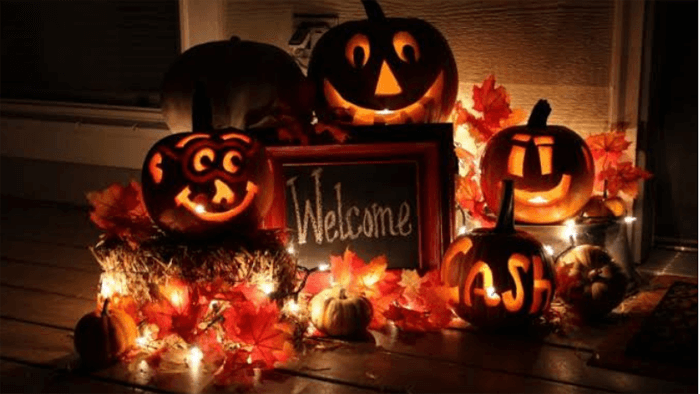Why Do People Celebrate Halloween

Halloween is All Hallows Eve which falls on 31st October and refers to the day before All Saints Day (November 1st). The first day of November is to honor all the saints who had no special days of their own. Saints were known as the hallowed, or holy, ones. Their special day was known as All Saints’, or All Hallows‘, Day. The night before was called All Hallows’ Even. All Hallows’ Even was shortened to Halloween.
For many years in the northern hemisphere, many different festivals have been associated with gathering in the harvest, preparing for winter, remembering loved ones who have died, and preparing for the time of longer nights and winter cold.
Autumn leaves, cornstalks, apples, and nuts are a big part of the Halloween season. These are reminders of the druids’ autumn festival in honor of the annual harvest. They believed that witches, demons, and spirits of the dead roamed the earth on the eve of November 1. Bonfires were lit to drive the bad spirits away.
To protect themselves further from the mean tricks of the bad spirits, the druids offered them good things to eat. They also disguised themselves. That way the spirits would think the druids belonged to their own evil company. Surely the spirits would not harm members of their own group! Or so the druids thought. Thus we celebrate Halloween by playing “trick or treat,” dressing up in costumes, and wearing masks.
Also Read: Halloween celebrated with different names around the world
Halloween’s origins date back to the ancient Celtic festival of Samhain (pronounced sow-in). The Celts, who lived 2,000 years ago in the area that is now Ireland, the United Kingdom, and northern France, celebrated their new year at the end of summer and the harvest and the beginning of the dark, cold winter, a time of year that was often associated with human death. Celts believed that on the night of October 31 the ghosts of the dead returned to earth.
When is Halloween
Halloween falls on October 31st each year. Halloween 2021 lands on Sunday.
Today Tradition of Halloween

-
Dressing up – typically as something deemed ‘scary’, – witches, vampires, demons, zombies, ghosts, skeletons, serial killers from films, etc.
-
Decorating – carving pumpkins, artificial spider webs, glow in the dark faces or weapons, masks, etc. Typical colors for the ‘theme’ are orange and black.
-
Trick or Treating – going from house to house after dark, knocking on doors, asking for sweets or other gifts. (And in some cases rewarding silent houses with ‘tricks’ such as egging).
-
Parties – Halloween parties can combine all of the above in one location as an organized party or as a base for trick-or-treating. There are various games like apple bobbing that are often played at Halloween.
People have been making jack-o’-lanterns at Halloween for centuries. The practice originated from an Irish myth about a man nicknamed “Stingy Jack.” According to the story, Stingy Jack invited the Devil to have a drink with him. Stingy Jack didn’t want to pay for his drink, so he convinced the Devil to turn himself into a coin that Jack could use to buy their drinks.
Once the Devil did so, Jack decided to keep the money and put it into his pocket next to a silver cross, which prevented the Devil from changing back into his original form. Jack eventually freed the Devil, under the condition that he would not bother Jack for one year and that, should Jack die, he would not claim his soul.
The next year, Jack again tricked the Devil into climbing into a tree to pick a piece of fruit. While he was up in the tree, Jack carved a sign of the cross into the tree’s bark so that the Devil could not come down until the Devil promised Jack not to bother him for ten more years. Soon after, Jack died.
As the legend goes, God would not allow such an unsavory figure into heaven. The Devil, upset by the trick Jack had played on him and keeping his word not to claim his soul, would not allow Jack into hell. He sent Jack off into the dark night with only a burning coal to light his way. Jack put the coal into a carved-out turnip and has been roaming the Earth with it ever since. The Irish began to refer to this ghostly figure as “Jack of the Lantern,” and then, simply “Jack O’Lantern.“
In Ireland and Scotland, people began to make their own versions of Jack’s lanterns by carving scary faces into turnips or potatoes and placing them into windows or near doors to frighten away Stingy Jack and other wandering evil spirits. In England, large beets are used. Immigrants from these countries brought the jack o’ lantern tradition with them when they came to the United States. They soon found that pumpkins, a fruit native to America, make perfect jack-o’-lanterns.
The American Halloween tradition of “trick-or-treating” probably dates back to the early All Souls’ Day parades in England. During the festivities, poor citizens begged for food and families gave them pastries called “soul cakes” in return for their promise to pray for the family’s dead relatives.
The tradition of dressing in costume for Halloween has both European and Celtic roots. On Halloween, when it was believed that ghosts came back to the earthly world, people thought that they would encounter ghosts if they left their homes. To avoid being recognized by these ghosts, people would wear masks when they left their homes after dark so that the ghosts would mistake them for fellow spirits. On Halloween, to keep ghosts away from their houses, people would place bowls of food outside their homes to appease the ghosts and prevent them from attempting to enter.
Happy Halloween: Quotes, Wishes, Messages, SMS, Facebook, and Whatsapp status






